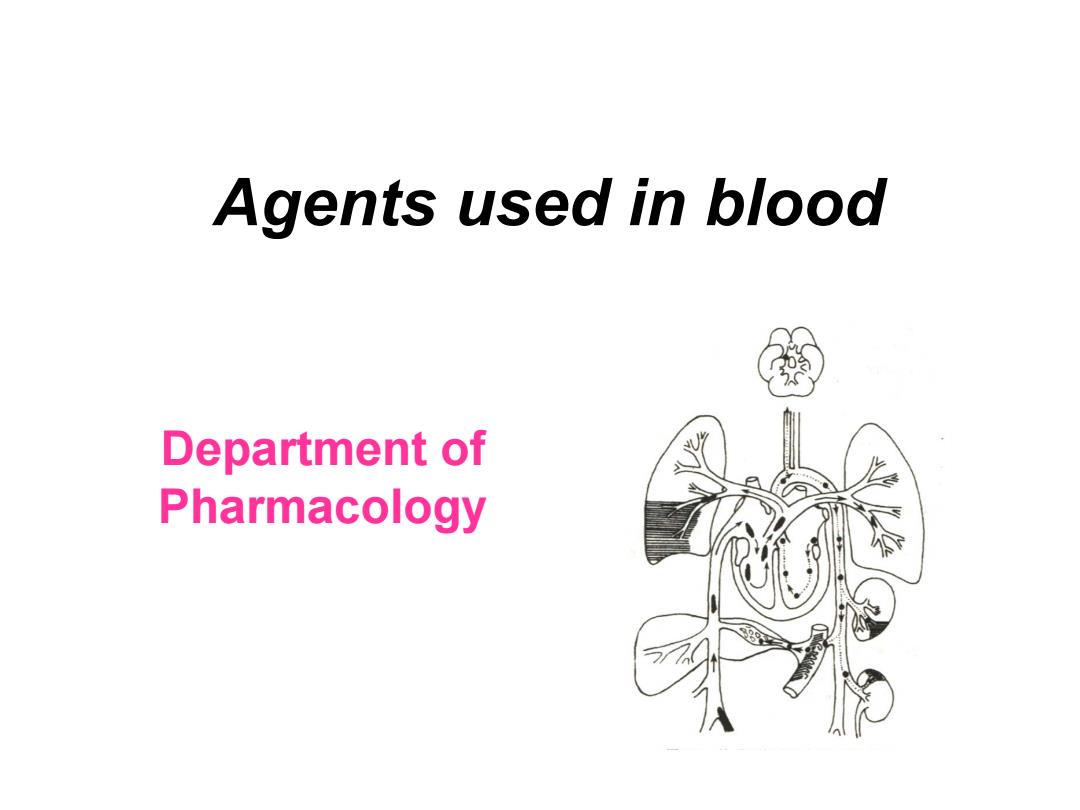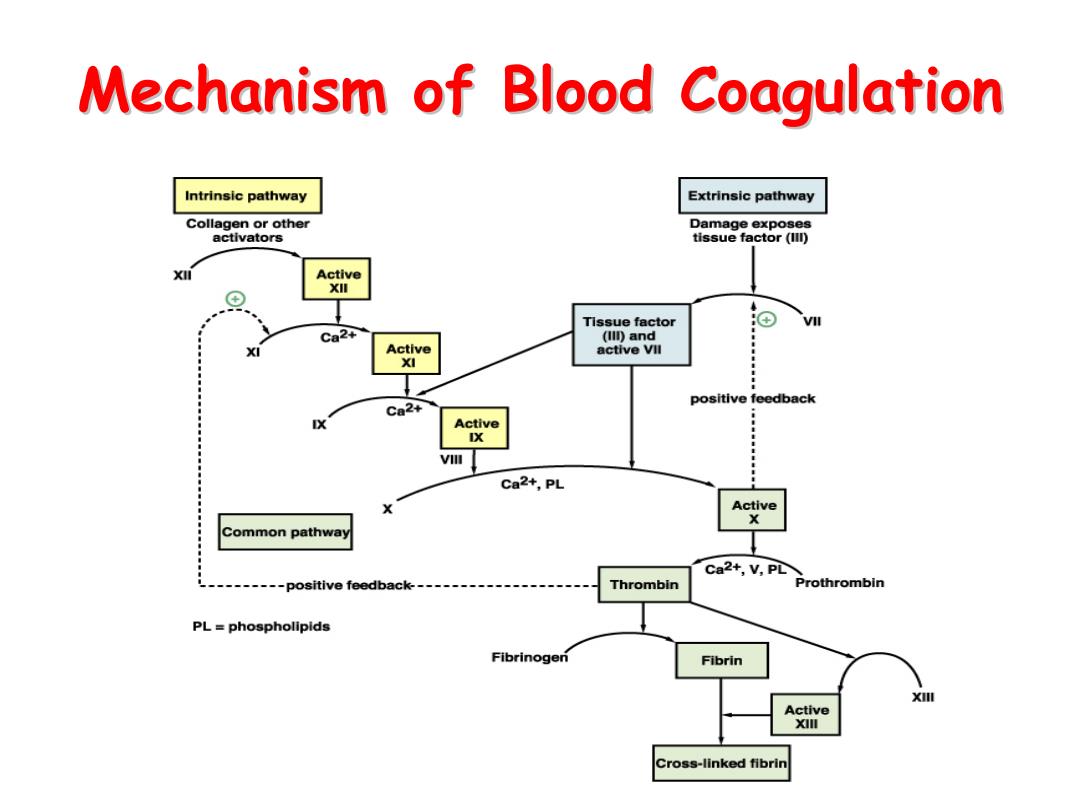
Agents used in blood 20 Department of Pharmacology
Agents used in blood Department of Pharmacology

Classification of drugs ●Anticoagulants ----Heparin,low molecular weight heparin ----Warfarin O Fibrinolytics Antipletelet drugs ● Treatment of bleeding ----Vitamin K ●Treatment of anemia ----Iron ----Cyanocobalamin (B12) ----Folic acid
●Anticoagulants ----Heparin, low molecular weight heparin ----Warfarin ● Fibrinolytics ● Antipletelet drugs ● Treatment of bleeding ----Vitamin K ● Treatment of anemia ----Iron ----Cyanocobalamin (B12) ----Folic acid Classification of drugs

Physiological hemostasis Damaged vessel Damaged endothelium Activated clotting vasospasm Platelet factors aggregation Platelet plug solid fibrin clot formed Arrest bleeding
Physiological hemostasis Damaged vessel vasospasm Activated clotting factors solid fibrin clot formed Platelet plug Arrest bleeding Platelet aggregation Damaged endothelium - -

Blood Clotting Factor Factor Name Plasma Synthesizing Half life Chromsome Concentration site site Fibrinogen 3000 Liver 4~5d 4 Il Prothrombin 100 Liver (with Vit K) 3d 11 Ill Tissue factor Endothelial cell IV Ca2+ 100 V Proaccelerin 10 Endothelial cell,platelet 12~15 h 1 VII Proconvertin 0.5 Liver (with Vit K) 4~7h 13 VII Antihemophilic factor,AHF 0.1 Liver 8~10h X IX Plasma thromboplastic 5 Liver (with Vit K) 24h X component,PTC(Christmas factor) X Stuart-Prower Factor 10 Liver(with Vit K) 2d 13 XI Plasma thromoboplastin 5 Liver 2~3d antecedent,PTA XII Contact factor or Hageman factor 40 Liver 24h 5 XIlI Fibrin-stabilizing factor 10 Liver,platelet 8d 6,1 High-molecular weight 80 Liver 3 kininogen,HMW-K Prekallikrein,Pre-K or Fletcher factor 35 Liver 、 4
I Fibrinogen 3000 Liver 4~5 d 4 II Prothrombin 100 Liver (with Vit K) 3 d 11 III Tissue factor - Endothelial cell - - IV Ca2+ 100 - - - V Proaccelerin 10 Endothelial cell, platelet 12~15 h 1 Ⅶ Proconvertin 0.5 Liver (with Vit K) 4~7 h 13 Ⅷ Antihemophilic factor,AHF 0.1 Liver 8~10 h Ⅹ Ⅸ Plasma thromboplastic 5 Liver (with Vit K) 24 h Ⅹ component,PTC(Christmas factor) Ⅹ Stuart-Prower Factor 10 Liver (with Vit K) 2 d 13 Ⅺ Plasma thromoboplastin 5 Liver 2~3 d 4 antecedent,PTA Ⅻ Contact factor or Hageman factor 40 Liver 24 h 5 XIII Fibrin-stabilizing factor 10 Liver, platelet 8 d 6,1 - High-molecular weight 80 Liver - 3 kininogen,HMW-K - Prekallikrein,Pre-K or Fletcher factor 35 Liver - 4 Factor Name Plasma Synthesizing Half life Chromsome Concentration site site Blood Clotting Factor Blood Clotting Factor

Mechanism of Blood Coagulation Intrinsic pathway Extrinsic pathway Collagen or other Damage exposes activators tissue factor(Ill) Active XII Tissue factor Ca2+ (Ill)and XI Active active Vll XI positive feedback Ca2+ Active X VIn Ca2+,PL X Active X Common pathway Ca2+,V,PL ---------positive feedback------------ Thrombin Prothrombin PL=phospholipids Fibrinogen Fibrin XI Active XIll Cross-linked fibrin
Mechanism of Blood Coagulation Mechanism of Blood Coagulation

Factor Xa 。Factor Xa is an Land Dwelling Vertebrates attractive target for the Tissue factor Surfaces (eg collagen) design of new oral XII anticoagulants XIa because of the unique IXa role factor Xa plays in the coagulation Xa cascade as a II(prothrombin)一◆Ila(Thrombin) XIIIa connection between riorinogen-:hrin-Stabilised Fibrin the extrinsic and intrinsic pathways
Factor Xa • Factor Xa is an attractive target for the design of new oral anticoagulants because of the unique role factor Xa plays in the coagulation cascade as a connection between the extrinsic and intrinsic pathways

FACTORS WHICH PROMOTE BLOOD FLUIDITY Normal Hemostasis Natural Anticoagulants Protein C ●Protein S ◆Antithrombin Ill Endothelial-Derived Anti-Platelet Substances ◆Nitric Oxide ·Prostacyclin(PGl2) Fibrinolytic System "clot busters" ·Plasmin 。Plasminogen Tissue Plasminogen Activator(tPA) Department of Pharmacology Howard University College of Medicine

History of Anticoagulants Jay McLean,a second year medical student at Johns Hopkins University,discovered this wonderful drug in 1916 while performing research in the laboratory of W.H.Howell,MD. 上uL: ✉ In 1960,DW Barritt and SC Jordan performed the first randomized trial showing the efficacy of anticoagulant therapy in the treatment of venous thromboembolism.Since then,important therapeutic advances have been made in the treatment of deep venous thrombosis and pulmonary embolism. .Barritt,D.W.,and Jordan,S.C.:Anticoagulant drugs in the treatment of pulmonary embolism.A controlled trial.Lancet,1:1309-1312,1960.[Medlinel
History of Anticoagulants In 1960, DW Barritt and SC Jordan performed the first randomized trial showing the efficacy of anticoagulant therapy in the treatment of venous thromboembolism. Since then, important therapeutic advances have been made in the treatment of deep venous thrombosis and pulmonary embolism. •Barritt, D. W., and Jordan, S. C.: Anticoagulant drugs in the treatment of pulmonary embolism. A controlled trial. Lancet, 1: 1309-1312, 1960.[Medline] Jay McLean, a second year medical student at Johns Hopkins University, discovered this wonderful drug in 1916 while performing research in the laboratory of W.H. Howell, MD

heparin chemistry and source Sulfated mucopolysaccharides large amount of negative charge strong acidity Characteristics administrated by i.v.or s.c. effective both in vivo and in vitro quick onset and potent effects anticoagulant activity is related to the length of molecular chain
heparin chemistry and source Sulfated mucopolysaccharides large amount of negative charge strong acidity Characteristics • administrated by i.v. or s.c. • effective both in vivo and in vitro • quick onset and potent effects • anticoagulant activity is related to the length of molecular chain

heparin---Mechanism Heparin works by inhibiting the three major clotting factors (thrombin,thromboplastin,and prothrombin). It slows the process of thromboplastin synthesis,decelerates the conversion of prothrombin to thrombin,and inhibits the effects of thrombin on fibrinogen,blocking its conversion to fibrin. heparin heparin AT Ill thrombin* AT II <thrombin* heparin heparin. AT III thrombin AT Ill thrombin* can also be Factor Xa
heparin AT III thrombin* AT III heparin thrombin* thrombin* heparin AT III AT III thrombin* heparin Fig. 50-3 * can also be Factor Xa heparin---Mechanism Heparin works by inhibiting the three major clotting factors (thrombin, thromboplastin, and prothrombin). It slows the process of thromboplastin synthesis, decelerates the conversion of prothrombin to thrombin, and inhibits the effects of thrombin on fibrinogen, blocking its conversion to fibrin